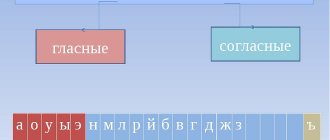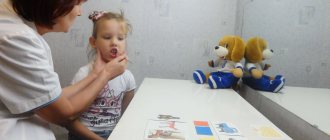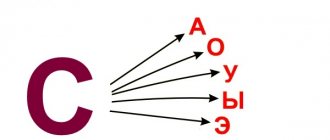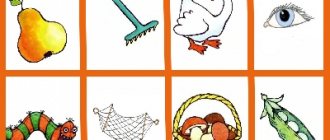Progress of the lesson on automation of sounds [K] and [G]
The lesson must be carried out using a mirror. You need to start with an analysis of the articulation of the phoneme. They use a variety of visual aids: picture plan, speech therapy profile, hand model, dummies. The child examines the position of the participating organs of the speech apparatus and determines the nature of the air flow. After analyzing the articulation, you need to characterize the phoneme according to the following plan: vowel/consonant (is there an obstacle to the exhaled air flow), voiceless/voiced (is the voice involved), hard/soft (is there an additional rise in the middle part of the lingual back).
Next, the pronunciation of the sound is practiced. Explosive [K] and [G] are worked on with a quick exhalation. For reinforcement, games with elements of onomatopoeia (what the sound is like) are used. Then you need to introduce the child to the letter indicating the phoneme [K] or [G]. Each time the child comes to the conclusion that the sound is heard and pronounced, and the letter can be seen, read, and written. Finds objects in the surrounding reality that are similar in appearance to a letter. If necessary, correct spelling is practiced. Non-graphic and graphic exercises are used, aimed at developing the skill of correctly depicting a letter.
After becoming familiar with the letter, they begin to improve phonemic processes. The child learns to isolate a sound from a number of phonemes that are similar in acoustic-articulatory characteristics, from a stream of syllables, from a list of words (the teacher compiles a set of words on the corresponding topic), and determines the presence and position of an automated sound in a word. If the level of speech development is insufficient, phonemes that are distant in their acoustic-articulatory characteristics are offered.
Next, the phoneme is fixed in syllables. The child repeats after the adult, pronounces in parallel with him and himself lists the syllables with the assigned phoneme. According to this principle, forward and backward syllables, as well as with a combination of consonants, are fixed. The voiced phoneme [G] is not fixed on the material of reverse syllables due to its deafening.
When the phoneme is accurately reproduced separately, you can move on to working on it in words. It is important to carry out only after isolated fastening. Words are selected by a speech therapist taking into account the lexical topic of each lesson. The child pronounces the word and indicates the place of the phoneme in it. Older preschoolers do a sound-syllable analysis with a graphic diagram of one word according to plan: the first and last sound are highlighted, the number of vowels and consonants is counted, all sounds are named one by one. Under each letter a colored chip is placed to indicate the sound.
Automation of the sound [G] in words ending in [G] is not carried out due to deafening.
Then they practice the correct sound in the phrase. The child constructs sentences with the words he has learned. Older preschoolers analyze the sentence: explain the definition; voice the basic rules of writing, establish the order of words, and count their number. A sound-syllable analysis of each word is performed separately. When practicing phonemes in a phrase, pure tongue twisters and tongue twisters are used, selected according to the lexical topic. Tongue twisters are great for the most successful reinforcement of phonemes. In addition, with the help of tongue twisters you can practice clear, precise diction.
At the final stage of automation of any phoneme, one should begin to consolidate it in coherent speech. The text is selected according to the child’s age, taking into account the lexical topic. The child is offered a text of 5-6 sentences, rich in words with the sound being studied. It is advisable to use excerpts from fairy tales, stories, and children's poems. The speech therapist or child reads the text, then selects words with an automated sound from the composition.
The structure of each automation lesson includes one or two dynamic breaks. Their time and place are determined taking into account the child’s condition and the degree of his fatigue. At the end of each lesson, the child receives homework. After automating the sound [K] in the text, automation [G] is carried out in a similar manner. Automation of the sound [Кь] and [Гь] is similar. The final stage of work on these phonemes is their differentiation.
Didactic exercises for automating the sounds [K] and [G]
Phonemes should be automated in play activities using a variety of visual aids. For each sound position in a word, about thirty images should be selected. For complete successful automation, show the child a card index of about a hundred pictures.
Effective results can only be achieved if classes are emotionally positive. The child should not just look at and name the objects depicted in the pictures, but play.
It is imperative to take into account words that are rarely used in everyday life. The meaning of new words must be explained in a language that is simple and understandable to the child, taking into account his individual and age characteristics.
Sample exercises:
- Together with an adult and independently name what is shown in the picture.
- Listen to how many times the adult repeated the sound and say one more. You can pronounce syllables and words in the same way.
- Remember what is drawn and reproduce from memory. Gradually the number of images increases.
- Divide words into syllables.
- Determine the stressed syllable.
- Select images with the required number of sounds and name them.
- Determine what place the automated phoneme occupies in words, select images with a sound that occupies a certain position in the word.
- Make a sound-syllable analysis of words.
- Change nouns by case.
- Count objects with an automated phoneme in forward and reverse order.
- Select nouns for the pronouns my, mine, mine, mine, and pronounce the resulting phrases.
- Select adjectives for nouns, pronounce phrases.
- Finish the phrase started by an adult using the sound being studied.
- Match verbs to nouns and pronounce the resulting phrases.
- Form nouns with diminutive suffixes.
- Form relative adjectives.
- Compose stories based on plot pictures using leading questions, supporting words, and a given beginning or ending.
- Come up with questions for images, texts, and answer them.
Games for automating the sounds [K] and [G]
The fourth one is extra. The child looks at four pictures. Three of them depict objects with an automated phoneme, one does not. The child names pictures, clearly articulates the assigned phoneme, and names an object that does not have a given sound. You can search for images where the location of the phoneme is different.
Suitable - not suitable . Look at the picture of the refrigerator, clarify its purpose, and list what can be stored in it. By looking at object pictures with a fixed phoneme, decide whether it is possible or not to store this object in the refrigerator.
Box. Show the child the doll, tell him that the doll likes to look at pictures and put them in a box. Ask the doll to look at its pictures together and name them, clearly articulating the desired sound. Magic colors. Draw an open box of paints on a piece of thick paper. Place stacks of colored mugs with pictures on the back on top of the paints. Explain that these are magical colors in which the pictures are hidden. The child’s task is to find and name them.
Lunch for a gnome . Look at the image of a plump gnome. Speculate why he is plump. Offer to come up with what he likes to eat. Words must have an automated sound. You can draw a skinny gnome and offer to feed him.









